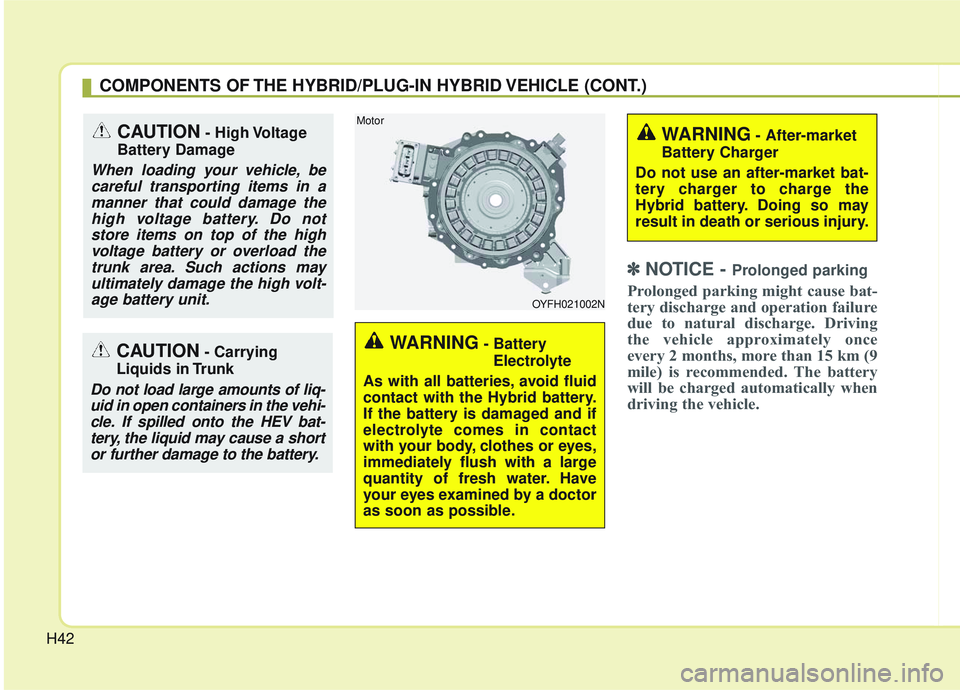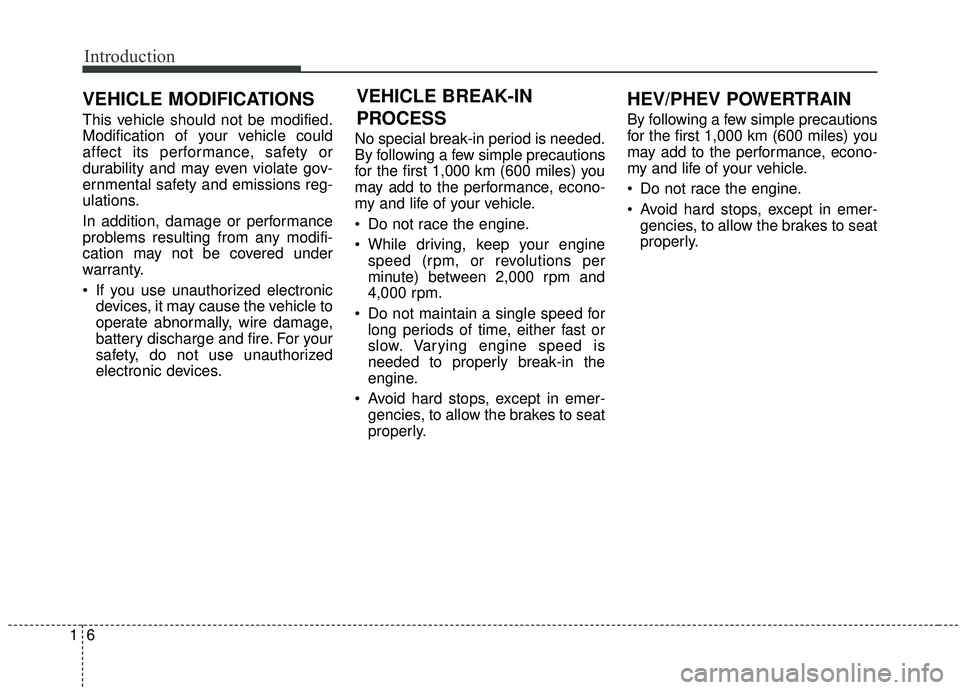Page 42 of 589

H42
✽ ✽NOTICE - Prolonged parking
Prolonged parking might cause bat-
tery discharge and operation failure
due to natural discharge. Driving
the vehicle approximately once
every 2 months, more than 15 km (9
mile) is recommended. The battery
will be charged automatically when
driving the vehicle.
CAUTION- High Voltage
Battery Damage
When loading your vehicle, be careful transporting items in amanner that could damage thehigh voltage battery. Do notstore items on top of the highvoltage battery or overload thetrunk area. Such actions mayultimately damage the high volt-age battery unit.
CAUTION- Carrying
Liquids in Trunk
Do not load large amounts of liq- uid in open containers in the vehi-cle. If spilled onto the HEV bat-tery, the liquid may cause a shortor further damage to the battery.
COMPONENTS OF THE HYBRID/PLUG-IN HYBRID VEHICLE (CONT.)
WARNING- Battery
Electrolyte
As with all batteries, avoid fluid
contact with the Hybrid battery.
If the battery is damaged and if
electrolyte comes in contact
with your body, clothes or eyes,
immediately flush with a large
quantity of fresh water. Have
your eyes examined by a doctor
as soon as possible.
OYFH021002N
Motor
WARNING- After-market
Battery Charger
Do not use an after-market bat-
tery charger to charge the
Hybrid battery. Doing so may
result in death or serious injury.
Page 43 of 589

H43
WARNING - High Waters
Avoid high waters as this may result in your vehicle becom-
ing saturated with water and
could compromise the high
voltage components.
Do not touch any of the high voltage components within
your vehicle if your vehicle
has been submerged in water
equal to half of the vehicle
height. Touching high voltage
components once submerged
in water could result in severe
burns or electric shock that
could result in death or seri-
ous injury.WARNING
-
Exposure to High Voltage
High voltage in the hybrid bat- tery system is very dangerous
and can cause severe burns
and electric shock. This may
result in serious injury or death.
For your safety, never touch, replace, dismantle or remove
any portion of the hybrid bat-
tery system including compo-
nents, cables and connectors.
CAUTION - Cleaning
Engine
When you clean the engine com-partment, do not wash usingwater. Water may cause electricarcing to occur and damage elec-tronic parts and components.
WARNING - Use of Water
or Liquids
If water or liquids come into
contact with the hybrid system
components, and you are also
in contact with the water, severe
injury or death due to electrocu-
tion may occur.
WARNING
-
Hot Components
When the hybrid battery system
operates, the HEV battery sys-
tem can be hot. Heat burns may
result from touching even insu-
lated components of the HEV
system.
Page 44 of 589

H44
COMPONENTS OF THE HYBRID/PLUG-IN HYBRID VEHICLE (CONT.)
Safety plugSome Special Features of the
Hybrid Vehicle.
Hybrid vehicles sound different than
gasoline engine vehicles. When the
hybrid system operates, you may
hear a sound from the hybrid battery
system behind the rear seat. If you
apply the accelerator pedal rapidly,
you may hear a sound. When you
apply the brake pedal, you may hear
a sound from the regenerative brake
system. When the hybrid system is
turned off or on, you may hear a
sound in the engine compartment. If
you depress the brake pedal repeat-
edly when the hybrid system is
turned on, you may hear a sound in
the engine compartment. None of
these sounds indicate a problem.
They are characteristics of hybrid
vehicles.
When the hybrid system is turned on,
the engine may run. This does not
indicate a malfunction. If the “ ”
symbol is on, the hybrid system is
operating. Even if the gasoline engine
is off, you can operate the vehicle.The HEV system may emit electromag-
netic waves which can affect the per-
formance of electronic devices appli-
ances, such as laptop computers,
which are not part of the vehicle design.
If you park the vehicle for a long time,
the hybrid system will discharge. You
need to drive the vehicle several times
per month to maintain a charge.
When you start the hybrid system in
the "P" transmission position, the
“ ” symbol is illuminated in the
cluster. The driver can drive the vehi-
cle even if the engine is stopped.
OJFHPQ018053
WARNING- Safety Plug
Never touch the safety plug.
Safety plug is attached to high
voltage hybrid battery system.
Touching safety plug will result
in death or serious injury.
Service personnel should follow
procedure in service manual.
WARNING- Turning off HEV system
When you leave the vehicle, you
should turn off the hybrid sys-
tem. If you depress the accelera-
tor pedal by mistake and the vehi-
cle is not in the "P" position, the
vehicle will accelerate. This may
result in serious injury or death.
Page 46 of 589

H46
COMPONENTS OF THE HYBRID/PLUG-IN HYBRID VEHICLE (CONT.)
If An Accident Occurs
Avoid the engine compartment.
Avoid making contact with anyorange or high voltage wires,
cables, or components.
Assume that a high voltage com- ponent is exposed and move away
from the vehicle as promptly as
possible.
Refer to Chapter 6 for towing infor- mation.
✽ ✽ NOTICE
• If a small scale fire occurs, use a
fire extinguisher rated ABC or BC
for electrical fires.
If it is impossible to extinguish the
fire in the early stage, remain a
safe distance from the vehicle and
immediately call 911. Also, advise
them that a hybrid vehicle is
involved.
If the fire spreads to the high volt-
age battery, large amount of water
is needed to put out the fire.
Using small amount of water or
fire extinguishers not meant for
electrical fires could cause serious
injury or death from electrical
shocks.
• If you need towing, refer to chap- ter 6.WARNING - Air Intake
Blocking the air intake behind the rear seats may damage
the HEV battery.
Do not allow any water to enter cleaning. If any water
enters the air intake, the
Hybrid battery may cause an
electric shock which can
cause serious injury or death
due to electrocution.
Page 57 of 589

Introduction
61
This vehicle should not be modified.
Modification of your vehicle could
affect its performance, safety or
durability and may even violate gov-
ernmental safety and emissions reg-
ulations.
In addition, damage or performance
problems resulting from any modifi-
cation may not be covered under
warranty.
If you use unauthorized electronicdevices, it may cause the vehicle to
operate abnormally, wire damage,
battery discharge and fire. For your
safety, do not use unauthorized
electronic devices. No special break-in period is needed.
By following a few simple precautions
for the first 1,000 km (600 miles) you
may add to the performance, econo-
my and life of your vehicle.
Do not race the engine.
While driving, keep your engine
speed (rpm, or revolutions per
minute) between 2,000 rpm and
4,000 rpm.
Do not maintain a single speed for long periods of time, either fast or
slow. Varying engine speed is
needed to properly break-in the
engine.
Avoid hard stops, except in emer- gencies, to allow the brakes to seat
properly. By following a few simple precautions
for the first 1,000 km (600 miles) you
may add to the performance, econo-
my and life of your vehicle.
Do not race the engine.
Avoid hard stops, except in emer-
gencies, to allow the brakes to seat
properly.
VEHICLE BREAK-IN
PROCESS HEV/PHEV POWERTRAIN
VEHICLE MODIFICATIONS
Page 81 of 589
317
Safety features of your vehicle
Armrest
To use the armrest, pull it forward
from the seatback.
Folding the rear seat (if equipped)
The rear seatbacks may be folded to
facilitate carrying long items or to
increase the luggage capacity of the
vehicle.
OJF035026
WARNING - Folded
Seatback
The purpose of the fold-down
rear seatbacks is to allow you to
carry longer objects that could
not otherwise be accommodated.
Never allow a passenger to sit on top of the folded down
seatback while the car is mov-
ing. This is not a proper seat-
ing position since no seat
belts are available for use.
To reduce the risk of injury caused by sliding cargo within
the passenger compartment
of the vehicle, objects carried
on the folded down seatback
should not extend higher than
the top of the front seats.
CAUTION - Blocked HEV
battery duct
Do not put objects in the centerlower part of rear seats. Thiscould block the battery coolingduct causing battery degradation.
OJFHQ015005
■Hybrid
Page 82 of 589
Safety features of your vehicle
18
3
To fold down the rear seatback
(for Hybrid, if equipped):
1. Make sure the rear seat belt web-
bing is in the guide to prevent the
seat belt from being damaged.
2. Set the front seatback to the upright position and if necessary,
slide the front seat forward.
3. Lower the rear headrests to the lowest position.
CAUTION - Blocked PHEV
Battery Duct
Do not put objects on the left
side of rear seat. This couldblock the battery cooling ductcausing battery degradation.
OJFHP036114L
■Plug-in hybrid
OJF035081L
WARNING - Objects
Objects carried on the folded
down seatback should not
extend higher than the top of
the front seatbacks. This could
allow cargo to slide forward and
cause injury or damage during
sudden stops.
Page 217 of 589

Features of your vehicle
82
4
EV/HEV (Plug-in hybrid)
A corresponding message is dis-
played when a mode is selected by
pressing the HEV button.
Low battery. Maintaining Hybrid
mode (Plug-in hybrid)
This message is displayed when
unable to convert to EV mode even
when pressing the HEV button dur-
ing HEV mode driving due to insuffi-
cient high-voltage(hybrid) battery
level.
Charger Error! (Plug-in hybrid)
This message is displayed when
there is a problem with the charger.
The purpose of this message is to let
you know an error has occurred in
charger itself not in vehicle.
Low/High System Temp.Maintaining Hybrid (Plug-in hybrid)
This message is displayed when
unable to convert to EV mode even
when pressing the HEV button dur-
ing HEV mode driving due to
low/high system temperature.
Switching to Hybrid mode toallow heating (Plug-in hybrid)
When the coolant temperature is lower than -14°C (57°F), and you
turn the climate control On for
heating, this message will be dis-
played in the cluster. Then, the
vehicle will automatically switch to
HEV mode.
When the coolant temperature is higher than -14°C (57°F), or you
turn the climate control Off, the
vehicle will automatically return to
EV mode.
Wait until fuel door opens
(Plug-in hybrid)
This message is displayed when you
attempt to open the fuel filler lid with
the fuel tank pressurized. Wait until
the fuel tank is depressurized.
✽ ✽ NOTICE
• It may take up to 20 seconds to
open fuel filler lid.
• When the fuel filler lid is frozen and does not open after 20 seconds
at freezing temperature, slightly
tap the fuel filler lid and then
attempt to open it.